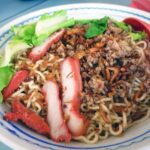Kuching Kolo Mee: The Famous Noodle Dish from Sarawak
Kolo Mee 哥罗面 also known as Kolok Mee, is a renowned noodle dish originating from Kuching, Sarawak. The name “Kolo” is derived from the Cantonese translation “gon lo”, meaning “dry mixed”.
The origins of Kolo Mee can be traced back to a Hakka businessman who settled in Kuching in 1920. He established a shop that sold “yan mee”, a dry-cooked noodle dish from his hometown. Initially served with a mix of Hakka minced meat and Cantonese roast pork slices, the taste and ingredients gradually evolved to suit local preferences. In the 1980s, due to word of mouth and the lack of signboards at local eateries, the noodles became known as “kolo mee” through the bastardization of the term “gon lo min” (dry mixed noodles).
Traditionally, Kolo Mee consists of blanched egg noodles tossed in pork lard and topped with sliced roast pork, minced pork, fish sauce, shallots, white pepper, and fried onions. Additional toppings vary among vendors, with some adding wontons, fresh pork slices, offal, fresh fish slices, prawns, fish balls, fishcake slices, choysum, and more. Kolo Mee is available in two common flavours: plain or red, the latter being seasoned with the sauce from char siew marinade.
The noodles are typically served with a bowl of soup and soy sauce on the side, allowing diners to adjust the saltiness to their liking. Freshly cut chillies are also served for those seeking additional heat.
Kolo Mee shares similarities with Kampua, a dry noodle dish from Sibu, in terms of appearance and taste. These dishes are likely siblings with the same origins. The main distinction is that Kolo Mee is often served with minced pork and cut chillies, while Kampua typically lacks these additions. Kolo Mee also features fancier toppings such as seafood, fish balls, and vegetables, while Kampua is usually served solely with thinly sliced roast pork. Kolo Mee can be prepared with different types of noodles, including vermicelli, flat rice noodles, flat egg noodles, or curly noodles. It is served in a bowl due to its more watery consistency, whereas Kampua is drier and served on a plate. However, the lines between the two dishes have blurred as noodle shops and stalls in Sarawak continue to innovate their offerings.
Today, you can easily find a traditional bowl of Kolo Mee throughout Kuching, served for breakfast, lunch, afternoon tea, dinner, or supper. While this noodle dish was initially consumed mainly by the Chinese community, it has gradually gained popularity among people of all races and religions in Kuching. Halal and Muslim-friendly versions of Kolo Mee, prepared with suitable ingredients, have also become increasingly common in the city.






1 Response
[…] bears a striking resemblance to Kolo Mee, a similar dish from Kuching, not only in appearance but also in taste. These dishes likely share […]